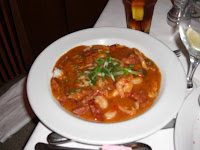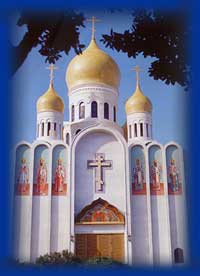
In early May of 1999, I had just left the parish in St. Paul, and I was drinking heavily enough to alarm my old friends from the Yale Russian Chorus, whom I had joined for a weekend party on Capri. I spent ten days after that eating and drinking near the piazza Esquilino, just downhill from the apse of Santa Maria Maggiore, originally a Constantinian Basilica, and one of the four Major Basilicas of the Roman Catholic Church. The piazza
is a lively little boulevard across the saddle of land between the Esquiline and Viminal hills.
Just below the basilica, the
Via Cavour crosses on its way from the railway station to the Coliseum.
Down the block is a small sidewalk bar, where I spent every evening drinking
Stavecchio and soda, reading the Herald Tribune, and watching the setting sun change the colors of the green and cream marble on the basilica.
One evening, there was a group of Americans at the next table. One of them was telling the rest about his travels with his motorcycle and photographic equipment. He was a large man. Not fat, but tall and well-built. He wore a beard and lots of rings and silver bracelets. A striking figure When I returned from the WC, he was alone, and I invited him to join me. (This is something almost unheard-of for me.) He told me his story.
His name was Lever, and he was planning to ride his motorcycle, Fulcrum, around the world. Since most of the trip would be through Russia, his native tongue would be useful. He explained that he and his mother emigrated to L.A. in the 70’s. His name was a sobriquet, made of his first name and initials, Lev, E, and R (Evgenievich Rukhin). I started speaking Russian to him. He had just ridden in from his girlfriend’s farm. He didn’t know where he was going in Rome. He saw the sidewalk café right next to a filling station, where he could keep an eye on Fulcrum from his table.
I asked him to tell me more about his background. Lever said that his father had been a well-known artist in the Soviet period, he had been an organizer of the infamous “bulldozer exhibit” in Moscow (an exhibition of avante garde painting in the Alexander Park outside the Kremlin, which had been officially permitted, and then destroyed by a bulldozer). Not long thereafter, Lever’s father died and he and his mother moved to the USA. I began to feel very creepy.
“What was your father’s name, again?” I asked.
“Evgenii Lvovich Rukhin.”
“Zhenia Rukhin”, I said.
“Yes.”
Whereupon I put my head in my hands and kept it there for a long time. When I looked up again, I told Lever than I knew his father. At which point, as I later learned, Lever got mad at me and thought I must be some kind of weird drunk. But I told him to sit still, I had a story to tell him.
In 1971, the year of his birth, I was received with the rest of rhe Yale Russian Chorus, at Zhenia’s ground-floor apartment on the Red Fleet Embankment overlooking the Neva. I remembered a grand piano and a harp. (This detail got Lever’s attention). We sang and drank, and Zhenia told me that he was planning to bring the newborn Lev to church to be baptized (a political statement in those days). Zhenia invited me to come back the next day.
I arrived at about 2:00 pm and everyone was already well into the vodka. Zhenia had had a meeting with the Minister of Culture (his boss, kind of, I guess), and he felt like getting drunk. We drank and talked and partied for about twelve hours. There were some others with us: a psychiatrist (Andrey) and the principal flautist of the Leningrad Philharmonic (Volodya) and a few more. We drank and sang and rode around on the water-taxis and ate chocolate and got stopped by the Militsia (at which point everyone else disappeared, and I was left to show my papers. I remember feeling that this was rather caddish behavior on their part, and told my friends so when they reappeared after the police left. Of course, I wasn’t thinking straight. I wasn’t in danger of getting into trouble, but they were.
Anyway, we picked up some more vodka, and stopped by Volodya’s house. He presented me with two fabulous medieval lutes, one of which was thought to have been ripped off from the Berlin Museum after the War. V. didn’t know anyone who could restore them. I smuggled them out and gave them to my friend, Rod Belleville, who was in the stringed-instrument repair business at the time. Then we went back to Zhenia’s and sent out for more vodka.
I finally went back to the hotel at about 2 am. Andrey escorted me, but let me walk the last two blocks alone, so as not to be seen by the authorities.
I recounted all this to Lever, who was growing more and more amazed. I observed that Zhenia had died in a dacha fire, which some thought suspicious.
“You really did know my father.”
“I knew Zhenia Rukhin.”
Lever and I spent the rest of the evening together, dined at a nice little restaurant near my hotel, and I gave him the use of the extra bed in my room. I stayed in loose touch with him for the subsequent nine years, but we were never in L.A. at the same time until now.
It is really great to be back in contact, and I expect to be more regular about it now.
Lever is a gifted and successful photographer. The visual arts are in his genes, no doubt. His father’s paintings now go for hundreds of thousands of dollars.




















































